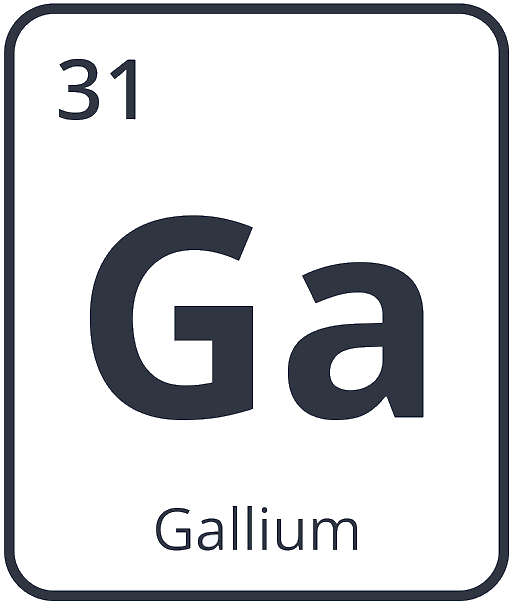Is Gallium Toxic? Exploring The Safety And Uses Of This Unique Metal
Gallium, a fascinating metal with unique properties, has gained attention across various industries, from electronics to medical applications. However, understanding whether gallium is toxic is crucial for its safe handling and usage. This article delves into the potential risks, safety precautions, and benefits of gallium, providing a comprehensive overview for both professionals and enthusiasts.
Gallium's growing presence in modern technology raises important questions about its safety. While it offers numerous advantages, understanding its toxicity levels and proper handling protocols is essential to avoid adverse effects. This article aims to provide clarity on these concerns.
By exploring scientific research, industry standards, and expert insights, we will address the question: Is gallium toxic? This detailed guide will cover everything you need to know about gallium, its properties, applications, and safety considerations.
Table of Contents
- Introduction to Gallium
- Physical Properties of Gallium
- Chemical Properties of Gallium
- Applications of Gallium
- Is Gallium Toxic? Understanding Toxicity Levels
- Safety Precautions When Handling Gallium
- Environmental Impact of Gallium
- Health Effects of Gallium Exposure
- Regulations and Standards for Gallium Handling
- Conclusion and Final Thoughts
Introduction to Gallium
Gallium is a soft, silvery metal with remarkable properties that make it highly valuable in various industries. Discovered in 1875 by French chemist Paul Émile Lecoq de Boisbaudran, gallium has become an essential material in modern technology. Its low melting point (29.76°C) and ability to form stable compounds have contributed to its widespread use.
In this section, we will explore the basics of gallium, including its discovery, natural occurrence, and production methods. Understanding these fundamentals is crucial for grasping its role in modern applications.
Discovery and History
Gallium was first identified using spectroscopy, making it one of the first elements discovered through this method. Its existence was predicted by Dmitri Mendeleev based on his periodic table theory. Today, gallium is primarily extracted as a byproduct of aluminum and zinc refining processes.
Physical Properties of Gallium
Gallium exhibits several unique physical properties that set it apart from other metals. Its ability to remain liquid at room temperature makes it an ideal material for specific applications. In this section, we will examine these properties in detail.
Key Physical Characteristics
- Low melting point (29.76°C)
- High boiling point (2,403°C)
- Density of 5.91 g/cm³
- Expansion properties when solidifying
These characteristics make gallium suitable for applications requiring thermal management and precision engineering.
Chemical Properties of Gallium
Gallium's chemical behavior is equally fascinating. It forms stable compounds with various elements, making it versatile in chemical applications. This section will explore its reactivity, oxidation states, and common compounds.
Common Gallium Compounds
- Gallium arsenide (GaAs)
- Gallium nitride (GaN)
- Gallium oxide (Ga₂O₃)
These compounds are widely used in semiconductors, LEDs, and other electronic devices.
Applications of Gallium
Gallium's unique properties have led to its adoption in numerous industries. From electronics to medical applications, its versatility continues to expand. This section will highlight the primary uses of gallium in modern technology.
Electronic Applications
Gallium arsenide and gallium nitride are integral components in semiconductor manufacturing. These materials enable faster and more efficient electronic devices, including:
- High-frequency transistors
- Light-emitting diodes (LEDs)
- Solar cells
Medical Uses
Gallium-based compounds are also used in medical imaging and cancer treatment. For example, gallium-67 citrate is utilized in nuclear medicine for diagnosing tumors and infections.
Is Gallium Toxic? Understanding Toxicity Levels
One of the most pressing questions about gallium is whether it poses a health risk. While gallium itself is not considered highly toxic, certain compounds and exposure scenarios can lead to adverse effects. This section will address the toxicity concerns associated with gallium.
Forms of Gallium Exposure
Gallium exposure can occur through inhalation, ingestion, or skin contact. The toxicity level depends on the form of gallium and the duration of exposure. According to the Agency for Toxic Substances and Disease Registry (ATSDR), gallium metal is less toxic than its compounds.
Safety Data
Research indicates that gallium arsenide, a commonly used semiconductor material, poses greater health risks compared to elemental gallium. Studies have shown that prolonged exposure to gallium arsenide dust may lead to respiratory issues and lung damage.
Safety Precautions When Handling Gallium
To ensure safe handling of gallium, proper precautions must be followed. This section will outline best practices for minimizing risks associated with gallium exposure.
Personal Protective Equipment (PPE)
- Gloves to prevent skin contact
- Goggles or face shields for eye protection
- Respiratory masks for inhalation risks
Storage and Disposal
Gallium should be stored in sealed containers away from heat sources. Proper disposal methods must be followed to prevent environmental contamination. Adhering to industry regulations ensures safe handling and reduces potential hazards.
Environmental Impact of Gallium
Gallium's environmental impact is another critical consideration. While it is not inherently harmful to ecosystems, improper disposal of gallium-containing materials can lead to contamination. This section will explore the environmental implications of gallium usage.
Recycling and Sustainability
Efforts to recycle gallium from electronic waste are gaining momentum. Recycling reduces the need for extracting new materials and minimizes environmental damage. Implementing sustainable practices in gallium production and usage is essential for long-term ecological health.
Health Effects of Gallium Exposure
Understanding the health effects of gallium exposure is vital for ensuring worker safety and public health. This section will discuss the potential risks and symptoms associated with gallium exposure.
Symptoms of Gallium Toxicity
- Respiratory irritation
- Skin and eye irritation
- Gastrointestinal discomfort
While acute toxicity is rare, chronic exposure to certain gallium compounds can lead to more severe health issues. Regular monitoring and safety training are essential for mitigating these risks.
Regulations and Standards for Gallium Handling
Gallium handling is governed by various regulations and standards to ensure safety and compliance. This section will highlight key guidelines and organizations involved in regulating gallium usage.
Key Regulatory Bodies
- Occupational Safety and Health Administration (OSHA)
- European Chemicals Agency (ECHA)
- International Agency for Research on Cancer (IARC)
These organizations provide comprehensive guidelines for safe gallium handling, including exposure limits and disposal protocols.
Conclusion and Final Thoughts
In conclusion, gallium is a remarkable metal with diverse applications in modern technology. While it is not highly toxic in its elemental form, certain compounds and exposure scenarios can pose health risks. By following proper safety protocols and adhering to regulatory standards, the risks associated with gallium usage can be effectively managed.
We encourage readers to share their thoughts and experiences with gallium in the comments section below. For further reading, explore our other articles on materials science and technology. Together, we can promote safe and sustainable practices in gallium handling and usage.
References:
- Agency for Toxic Substances and Disease Registry (ATSDR)
- Occupational Safety and Health Administration (OSHA)
- European Chemicals Agency (ECHA)



Detail Author:
- Name : Dr. Horacio Bayer
- Email : lucie06@denesik.com
- Birthdate : 1999-05-20
- Address : 6082 Greyson Mission Suite 742 Stromanhaven, HI 20953-6194
- Phone : +16124598053
- Company : Pagac-Mraz
- Job : Gas Plant Operator
- Bio : Quis ducimus et est voluptatibus eum commodi est. Aut nulla assumenda repellendus dolor. Natus ducimus voluptatem in. Itaque culpa quidem ullam tenetur.